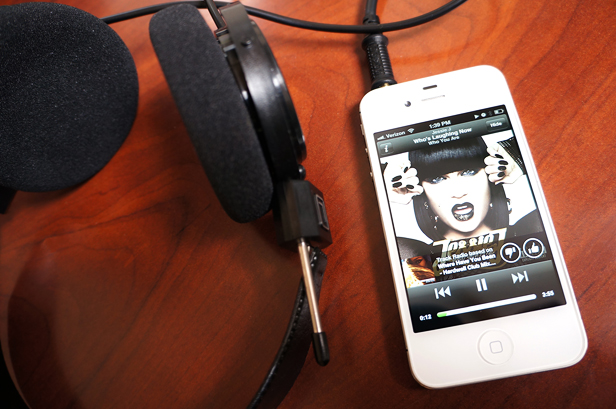Review: Spotify’s Mobile Internet Radio

I’ve long been a fan of the Internet radio service Pandora—even more so since I got a car and discovered the joy of streaming music with it while on the go.
But now there’s another free Internet radio service for the iPhone and iPad. It comes from a familiar face: Spotify, the popular online music streaming service that lets you listen to over 16 million tunes free with occasional advertising interruptions—or without ads, and with additional features, for a monthly fee.
Spotify added a free radio feature to its iPhone and iPad apps on Tuesday. The apps were previously meant for users of its premium service, which for $10 per month includes the ability to listen to on-demand tunes on your smart phone. With the radio feature, which already existed within Spotify’s desktop computer software, Spotify becomes more alluring, and some of its nonpaying users may be convinced to sign up for its paid offerings.
I spent some time playing with Spotify’s radio feature and found it generally on par with Pandora but in some ways even more useful.
Function-wise, the Spotify feature is very similar to Pandora’s app. You can choose from a number of stations preselected by genre, or create customized stations by selecting a particular artist or song and having Spotify automatically cue up similar stuff. You can then pause tracks and tap a little on-screen thumbs-up or thumbs-down to indicate that you loved or hated a song selected for you, increasing the chances that you’ll like the station’s future selections better. You can also indicate favorite songs and skip several tracks during playback by hitting a fast-forward button or swiping from right to left on the screen.
There are a few key differences with Pandora, though. Just as Spotify’s main music-streaming service lets users create playlists that they can share with friends, the radio service cleverly allows you to create stations based on these playlists, and you can save songs to your own Spotify lists for later listening. The app also seems to have more sharing options than Pandora’s: you can share songs on Facebook or Twitter, via text message or e-mail, or simply by copying the track link and pasting it elsewhere.
Of course, nothing is completely free. Like its chief competitor, Spotify’s radio feature runs ads (if you already pay for Spotify’s $5-per-month or $10-per-month service, your radio experience will be ad-free; Pandora also offers a $4-per-month version of its service that eschews ads). The ads seemed to interrupt music playback about as frequently as they do on Pandora’s free app, but I didn’t notice ads popping up to cover the on-screen album art as they do on Pandora.
The main issue I had with Spotify’s radio app was that its design felt cluttered and confusing. The “Now Playing” screen is pretty clean, with basic artist and song details, album art, and controls. But the main radio screen has small type and lots of little images—not easy for either a passenger or a driver to use while speeding down the road, which I’m sure people will want to do. Also, I couldn’t find any way to delete radio stations, which meant that the more stations I added, the more I had to scroll through.
The Spotify app could also use some more artist information. Tapping a little “i” in the top left corner of the screen will lead you to a list of tracks on the album you’re listening to and the artist’s discography, but I couldn’t find any details about the artist or song.
Still, Spotify is on to something. I’m not saying good-bye to Pandora, but the next time I’m in the car, I may be taking Spotify for a spin.
Keep Reading
Most Popular
Large language models can do jaw-dropping things. But nobody knows exactly why.
And that's a problem. Figuring it out is one of the biggest scientific puzzles of our time and a crucial step towards controlling more powerful future models.
The problem with plug-in hybrids? Their drivers.
Plug-in hybrids are often sold as a transition to EVs, but new data from Europe shows we’re still underestimating the emissions they produce.
How scientists traced a mysterious covid case back to six toilets
When wastewater surveillance turns into a hunt for a single infected individual, the ethics get tricky.
Google DeepMind’s new generative model makes Super Mario–like games from scratch
Genie learns how to control games by watching hours and hours of video. It could help train next-gen robots too.
Stay connected
Get the latest updates from
MIT Technology Review
Discover special offers, top stories, upcoming events, and more.